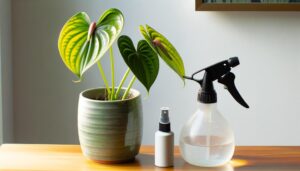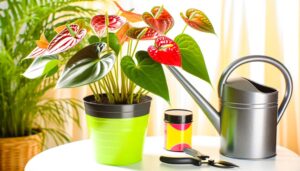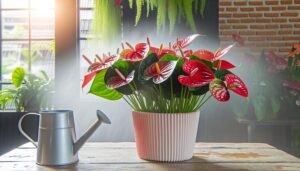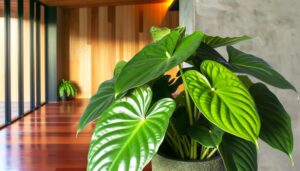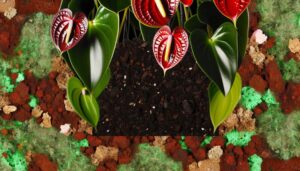Anthurium Plowmanii Care – The Ultimate Guide
For Anthurium Plowmanii care, place it in bright, indirect light, avoiding direct sun. Maintain soil moisture with a well-draining mix, watering when the top 1-2 inches are dry.
Temperatures should be between 65-80°F with humidity above 60%. Use a balanced 20-20-20 fertilizer diluted to half-strength every 6-8 weeks.
Ensure proper ventilation and promptly trim yellowing leaves and soft roots. To propagate, either divide the root system or use stem cuttings.
Regular checks for pests and root health are crucial. Stick around to master every aspect of nurturing this stunning plant.
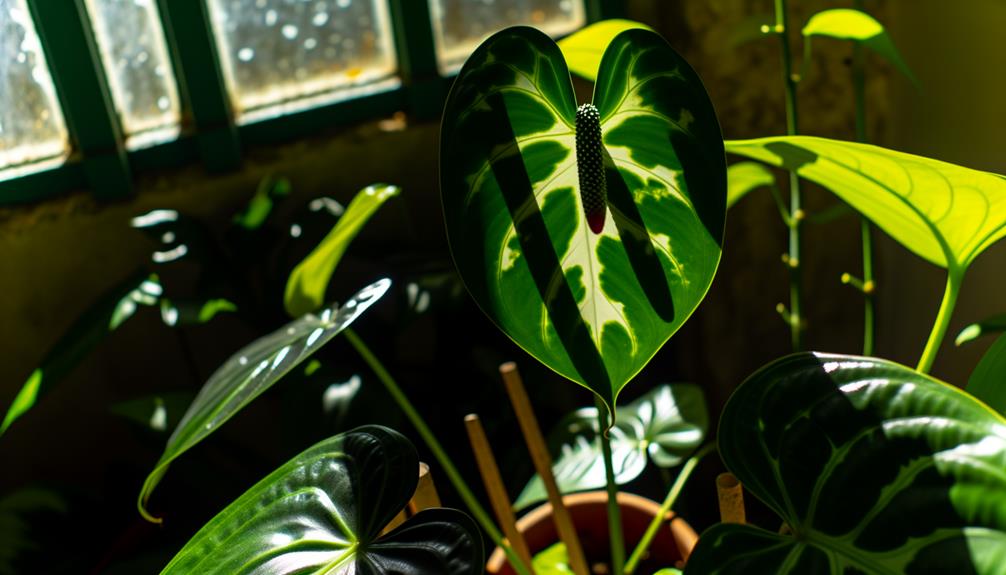
Key Takeaways
- Place Anthurium Plowmanii in bright, indirect light away from direct sunlight.
- Maintain consistent soil moisture with a well-draining soil mix to prevent root rot.
- Ensure temperatures between 65-80°F and humidity levels above 60%.
- Fertilize with a diluted 20-20-20 mix every 6-8 weeks during the growing season.
- Propagate by separating root sections or using stem cuttings with a few leaves.
Ideal Lighting Conditions

For Anthurium plowmanii to thrive, you should place it in bright, indirect light to mimic its natural understory habitat. This plant naturally grows beneath the forest canopy, where it receives filtered sunlight.
Direct sunlight can scorch its leaves, leading to unsightly damage and reduced essentiality. Position your Anthurium near an east or north-facing window, where it can enjoy gentle morning light.
If natural light is insufficient, consider using grow lights. Guarantee these lights are kept at a distance to avoid overheating the plant.
Regularly rotate the pot to encourage even growth and prevent the plant from leaning towards the light source. By providing optimal lighting, you’ll help your Anthurium flourish and serve as a beautiful focal point in any space.
Watering Requirements
To keep your Anthurium Plowmanii healthy, following an ideal watering schedule is crucial. It is important to make sure the soil stays consistently moist but not waterlogged.
Watch for signs of overwatering, such as yellowing leaves and root rot, which can be harmful to the plant.
Proper drainage methods are essential. Using a well-draining potting mix and ensuring your pot has drainage holes will help prevent these issues.
Optimal Watering Schedule
Watering Anthurium plowmanii correctly is crucial for its health, requiring a balance between keeping the soil moist and preventing waterlogged roots.
You should water when the top 1-2 inches of soil feels dry to the touch. Typically, this means watering every 7-10 days, though frequency can vary based on environmental conditions.
Use room-temperature, filtered water to avoid shocking the roots. Make sure the pot has drainage holes to prevent excess water accumulation.
Increase humidity around the plant by misting or using a humidity tray. During winter, reduce watering frequency as the plant’s growth slows.
Signs of Overwatering
Monitoring the signs of overwatering is just as essential as sticking to a proper watering schedule to ensure your Anthurium plowmanii stays healthy.
Look for yellowing leaves, as this often indicates waterlogged roots. Another sign is wilting, which may seem counterintuitive but results from root rot impairing water uptake.
Check for a musty smell from the soil—this suggests fungal growth due to excess moisture. Feel the soil; if it’s consistently wet, you’re likely overwatering.
Brown leaf tips can also indicate water stress. By recognizing these signs early, you can adjust your watering habits and prevent long-term damage.
Proper Drainage Techniques
Promoting proper drainage is essential for Anthurium plowmanii, as it prevents water from pooling around the roots, which can lead to root rot and other moisture-related issues.
To achieve peak drainage, follow these practical steps:
- Select a well-draining soil mix: Use a combination of orchid bark, perlite, and peat moss. This mix provides aeration while retaining necessary moisture.
- Use pots with drainage holes: Always choose pots that have multiple drainage holes at the bottom. This ensures excess water can escape easily.
- Elevate the pot: Place your pot on a raised surface or use pot feet. This allows air circulation underneath and helps prevent water accumulation.
Soil Preferences
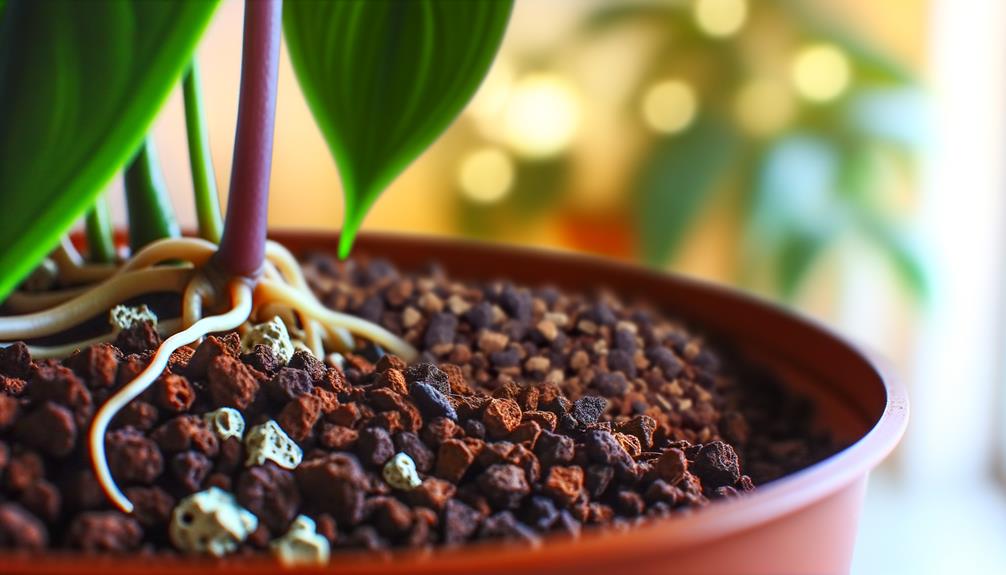
For best growth, you should use a well-draining, aerated soil mix for your Anthurium Plowmanii. Aim for a composition with equal parts orchid bark, perlite, and peat moss to guarantee proper moisture retention and air circulation.
This combination prevents root rot and promotes a healthy root system.
Ideal Soil Composition
What makes an ideal soil composition for Anthurium Plowmanii is a well-draining, airy mix that mimics its natural epiphytic environment.
You’ll want to use a blend that allows ample oxygen to reach the roots while retaining enough moisture.
Here’s a practical mix you can create:
- Orchid Bark: This provides excellent aeration and mimics the plant’s natural habitat.
- Perlite: It enhances drainage and prevents soil compaction, ensuring the roots have room to breathe.
- Peat Moss or Coco Coir: These components retain moisture without becoming waterlogged, maintaining a balanced hydration level.
Drainage and Aeration
Proper drainage and aeration in the soil are essential in preventing root rot and promoting healthy root development in Anthurium Plowmanii.
You’ll want to use a well-draining soil mix that includes components like perlite, orchid bark, and peat moss.
These ingredients guarantee the soil remains breathable and prevents water from pooling around the roots.
Here’s a quick reference table for an ideal soil mix:
| Component | Purpose |
|---|---|
| Perlite | Enhances drainage |
| Orchid Bark | Increases aeration |
| Peat Moss | Retains moisture |
| Charcoal | Guards against root diseases |
| Coco Coir | Enhances water retention |
Temperature and Humidity
To achieve peak growth, Anthurium Plowmanii thrives in temperatures between 65-80°F and requires high humidity levels, ideally above 60%. Consistent temperature and humidity are essential for this tropical plant’s health.
Here’s how you can guarantee ideal conditions:
- Use a Hygrometer: Regularly measure humidity levels around your plant. If it drops below 60%, consider using a humidifier.
- Misting: Lightly mist the leaves daily to mimic the plant’s natural rainforest habitat. Ensure the leaves dry quickly to prevent fungal issues.
- Temperature Control: Maintain a stable indoor temperature. Avoid placing the plant near drafty windows, air conditioners, or heating vents, which can cause stress.
Fertilizing Tips
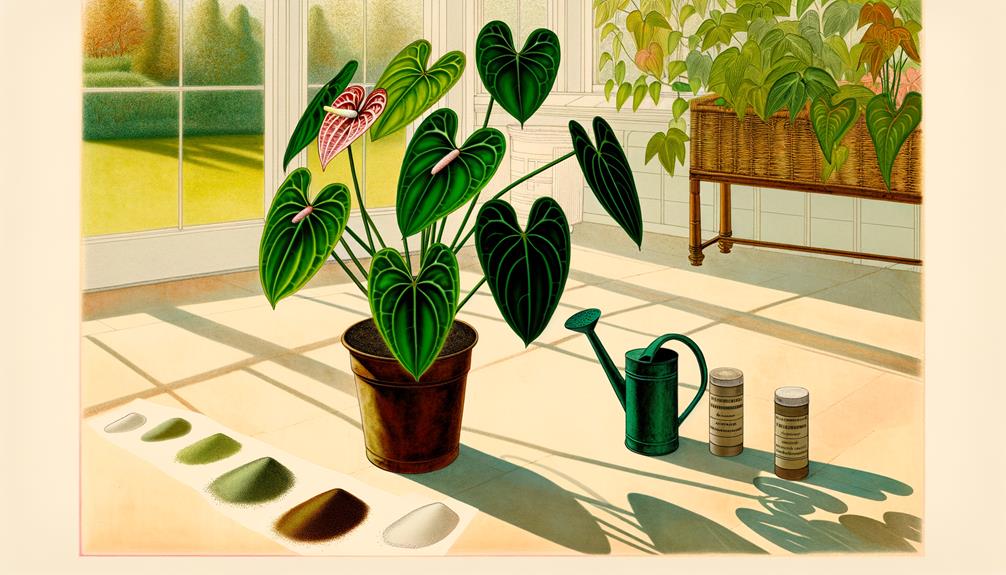
Maintaining ideal temperature and humidity is just one piece of the puzzle; you’ll also need to provide the right nutrients through careful fertilization to guarantee your Anthurium Plowmanii thrives. Use a balanced fertilizer, preferably a 20-20-20 mix, to supply essential nutrients.
Apply it every 6-8 weeks during the growing season. Dilute the fertilizer to half-strength to avoid nutrient burn, ensuring the plant absorbs nutrients efficiently. Organic options like compost tea can also offer a gentler nutrient boost.
Always water the plant thoroughly before applying fertilizer to prevent root damage. Keep an eye on yellowing leaves, which may indicate over-fertilization. By following these tips, you’ll help your Anthurium Plowmanii grow robustly and sustain its vibrant foliage.
Pruning and Maintenance
Regular pruning and maintenance are essential for keeping your Anthurium Plowmanii healthy and promoting new growth. By removing dead or damaged leaves, you can encourage the plant to focus its energy on producing vibrant, new foliage.
Here’s a detailed guide to help you:
- Use sterile tools: Always sterilize your pruning shears or scissors to prevent the spread of pathogens. A solution of one part bleach to nine parts water works well.
- Remove dead leaves: Cut off any yellowing or brown leaves at the base. This not only improves the appearance but also prevents potential disease.
- Trim aerial roots: If the aerial roots become unruly, trim them back slightly, ensuring you don’t damage the plant. This helps maintain a neat appearance.
Common Pests and Diseases

When looking after Anthurium Plowmanii, you’ll often come across typical pests and diseases that can compromise the plant’s health.
Aphids, mealybugs, and spider mites are frequent intruders. To address these, regularly examine leaves and stems for signs of infestation. Use insecticidal soap or neem oil to treat affected areas.
Bacterial blight and root rot are common diseases that can afflict your Anthurium. Prevent bacterial blight by ensuring proper air circulation and avoiding waterlogged soil.
For root rot, refrain from overwatering and confirm the pot has adequate drainage. If you notice any yellowing leaves or soft, mushy roots, trim the affected parts immediately.
Consistent monitoring and proactive measures will help you maintain a healthy and flourishing Anthurium Plowmanii.
Propagation Methods
After ensuring your Anthurium Plowmanii is free of pests and diseases, you can propagate the plant through division or stem cuttings to expand your collection.
Here’s a step-by-step guide:
Division: Gently remove the plant from its pot and separate the root system into smaller sections, ensuring each section has healthy roots and leaves. Replant these sections in fresh soil.
Stem Cuttings:
Use a sterilized knife to cut a healthy stem with a few leaves. Place the cutting in water or a moist substrate until roots develop, then transfer it to soil.
Care: Keep new plants in a humid, warm environment and provide indirect light. Regularly check for root development and pests.
These methods guarantee healthy propagation and plant growth.
Conclusion
Caring for your Anthurium plowmanii is like tending to a delicate symphony. Each element—light, water, soil, temperature, and nutrients—plays its part. When you harmonize these factors, your plant flourishes, dancing with vibrant leaves and robust health.
Just as a conductor guides an orchestra, your attentive care orchestrates a thriving Anthurium. Remember, even the smallest note, like pruning or pest control, contributes to the masterpiece.
Nurture it well, and nature’s concert will reward you.

